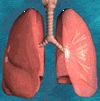 1
1
 1 1 |
 |
|
03/29/02 |
    
|
The air we breathe in is 21% O2 and 79% N2, (neglecting humidity). When the air reaches the lungs, some of this oxygen is transferred to the blood, and is then transported throughout the body to be used for energy. In addition, the blood contains some carbon dioxide (a waste product) that is transferred to the air in the lungs, and then exhaled. The result is that the exhaled air contains less oxygen and more carbon dioxide than the inhaled air. The air in the lungs also becomes humidified with water before it is exhaled. In fact, exhaled air is completely saturated with water – it contains the maximum amount of moisture, and is therefore has a relative humidity of 100%. We lose water as we breathe! The typical composition of exhaled air is about 18% O2, 78% N2, and 4.0% CO2. We will perform an experiment to measure the air flow rate during breathing, and the oxygen and carbon dioxide content of the exhaled air. We will apply the ideal gas law and material balances to determine the rates at which oxygen and carbon dioxide are exchanged between the lungs and the body.
|
This site was last updated 02/15/02
1. www.bme.umich.edu